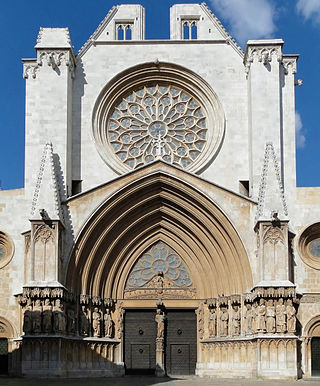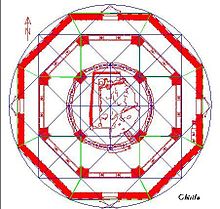
Anglo-Saxon architecture was a period in the history of architecture in England from the mid-5th century until the Norman Conquest of 1066. Anglo-Saxon secular buildings in Britain were generally simple, constructed mainly using timber with thatch for roofing. No universally accepted example survives above ground. Generally preferring not to settle within the old Roman cities, the Anglo-Saxons built small towns near their centres of agriculture, at fords in rivers or sited to serve as ports. In each town, a main hall was in the centre, provided with a central hearth.

Yakushi-ji (薬師寺) is one of the most famous imperial and ancient Buddhist temples in Japan, and was once one of the Seven Great Temples of Nanto, located in Nara. The temple is the headquarters of the Hossō school of Japanese Buddhism. Yakushi-ji is one of the sites that are collectively inscribed as a UNESCO World Heritage Site under the name of "Historic Monuments of Ancient Nara."

Kōfuku-ji is a Buddhist temple that was once one of the powerful Seven Great Temples in the city of Nara, Japan. The temple is the national headquarters of the Hossō school.

The Window of the World is a theme park located in the western part of the city of Shenzhen in the People's Republic of China. It has about 130 reproductions of some of the most famous tourist attractions in the world squeezed into 48 hectares. The 108 metre (354 ft) tall Eiffel Tower dominates the skyline and the sight of the Pyramids and the Taj Mahal all in proximity to each other are all part of the appeal of this theme park.

Hokki-ji or Hōki-ji – formerly known as Okamoto-dera (岡本寺) and Ikejiri-dera (池後寺) – is a Buddhist temple in Okamoto, Ikaruga, Nara Prefecture, Japan. The temple's honorary sangō prefix is "Kōhonzan" (岡本山), although it is rarely used. The temple was constructed to honor Avalokitesvara, and an 11-faced statue of the goddess is the primary object of worship in the temple. Hokki-ji is often considered to be one of the seven great temples founded by Prince Shōtoku, but in fact the temple was not completed until some decades after his death. In 1993, it was registered together with Hōryū-ji as an UNESCO World Heritage Site under the name Buddhist Monuments in the Hōryū-ji Area.

Hōrin-ji, or Mii-dera is a Buddhist temple in Mii, Ikaruga, Nara, Japan. The temple is located about a kilometer north of Hōryū-ji's Tō-in. The temple's sangō prefix is Myōken-san (妙見山).

English Gothic is an architectural style that flourished from the late 12th until the mid-17th century. The style was most prominently used in the construction of cathedrals and churches. Gothic architecture's defining features are pointed arches, rib vaults, buttresses, and extensive use of stained glass. Combined, these features allowed the creation of buildings of unprecedented height and grandeur, filled with light from large stained glass windows. Important examples include Westminster Abbey, Canterbury Cathedral and Salisbury Cathedral. The Gothic style endured in England much longer than in Continental Europe.
Diotisalvi, also Deotisalvi or Deustesalvet, was an architect from Pisa, Italy, active in the 12th century in Pisa. Little is known of him.

Buddhism played an important role in the development of Japanese art between the 6th and the 16th centuries. Buddhist art and Buddhist religious thought came to Japan from China through Korea. Buddhist art was encouraged by Crown Prince Shōtoku in the Suiko period in the sixth century, and by Emperor Shōmu in the Nara period in the eighth century. In the early Heian period, Buddhist art and architecture greatly influenced the traditional Shinto arts, and Buddhist painting became fashionable among wealthy Japanese. The Kamakura period saw a flowering of Japanese Buddhist sculpture, whose origins are in the works of Heian period sculptor Jōchō. During this period, outstanding busshi appeared one after another in the Kei school, and Unkei, Kaikei, and Tankei were especially famous. The Amida sect of Buddhism provided the basis for many popular artworks. Buddhist art became popular among the masses via scroll paintings, paintings used in worship and paintings of Buddhas, saint's lives, hells and other religious themes. Under the Zen sect of Buddhism, portraiture of priests such as Bodhidharma became popular as well as scroll calligraphy and sumi-e brush painting.

Shichidō garan is a Japanese Buddhist term indicating the seven halls composing the ideal Buddhist temple compound. This compound word is composed of shichidō (七堂), literally meaning "seven halls", and garan (伽藍), meaning "temple". The term is often shortened to just garan. Which seven halls the term refers to varies, and 七堂 may be a misinterpretation of shitsudō (悉堂), meaning "complete temple". In practice, shichidō garan often simply means a large temple with many buildings.

Hōryū-ji is a Buddhist temple that was once one of the powerful Seven Great Temples, in Ikaruga, Nara Prefecture, Japan. Its full name is Hōryū Gakumonji (法隆学問寺), or Learning Temple of the Flourishing Law, the complex serving as both a seminary and monastery.

The UNESCO World Heritage Site Buddhist Monuments in the Hōryū-ji Area includes a variety of buildings found in Hōryū-ji and Hokki-ji in Ikaruga, Nara Prefecture, Japan. These buildings were designated in 1993 along with the surrounding landscape, under several criteria. The structures inscribed are some of the oldest extant wooden buildings in the world, dating from the 7th to 8th centuries. Many of the monuments are also National Treasures of Japan, and reflect an important age of Buddhist influence in Japan. The structures include 21 buildings in the Hōryū-ji East Temple, 9 in the West Temple, 17 monasteries and other buildings, and the pagoda in Hokki-ji.

The Primatial Cathedral of Tarragona is a Roman Catholic church in Tarragona, Catalonia, Spain. The edifice is located in a site previously occupied by a Roman temple dating to the time of Tiberius, a Visigothic cathedral, and a Moorish mosque. It was declared a national monument in 1905.

The early domes of the Middle Ages, particularly in those areas recently under Byzantine control, were an extension of earlier Roman architecture. The domed church architecture of Italy from the sixth to the eighth centuries followed that of the Byzantine provinces and, although this influence diminishes under Charlemagne, it continued on in Venice, Southern Italy, and Sicily. Charlemagne's Palatine Chapel is a notable exception, being influenced by Byzantine models from Ravenna and Constantinople. The Dome of the Rock, an Umayyad Muslim religious shrine built in Jerusalem, was designed similarly to nearby Byzantine martyria and Christian churches. Domes were also built as part of Muslim palaces, throne halls, pavilions, and baths, and blended elements of both Byzantine and Persian architecture, using both pendentives and squinches. The origin of the crossed-arch dome type is debated, but the earliest known example is from the tenth century at the Great Mosque of Córdoba. In Egypt, a "keel" shaped dome profile was characteristic of Fatimid architecture. The use of squinches became widespread in the Islamic world by the tenth and eleventh centuries. Bulbous domes were used to cover large buildings in Syria after the eleventh century, following an architectural revival there, and the present shape of the Dome of the Rock's dome likely dates from this time.

Perpendicular Gothic architecture was the third and final style of English Gothic architecture developed in the Kingdom of England during the Late Middle Ages, typified by large windows, four-centred arches, straight vertical and horizontal lines in the tracery, and regular arch-topped rectangular panelling. Perpendicular was the prevailing style of Late Gothic architecture in England from the 14th century to the 17th century. Perpendicular was unique to the country: no equivalent arose in Continental Europe or elsewhere in the British Isles. Of all the Gothic architectural styles, Perpendicular was the first to experience a second wave of popularity from the 18th century on in Gothic Revival architecture.

Hirakawa temple ruins is an archeological site with the ruins of a Nara period Buddhist temple located in the Hirakawa-Furumiya neighborhood of the city of Jōyō, Kyoto, Japan. It was designated as a National Historic Site in 1975 with the area under protection expanded in 2008.





















